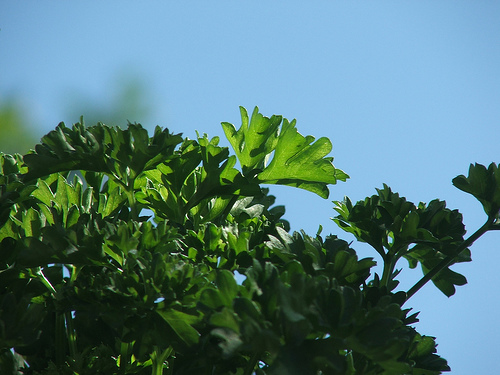All about parsley
For a lot of people, parsley is just a garnish. That weird little frilly green thing you leave behind on your plate at the restaurant. Others know parsley as a dull and boring dried spice which seems to have no Earthly use.
This is a real shame, because not only is parsley delicious, it is also ridiculously good for you. This vibrant green herb will not only improve your meals, it will also improve your health!
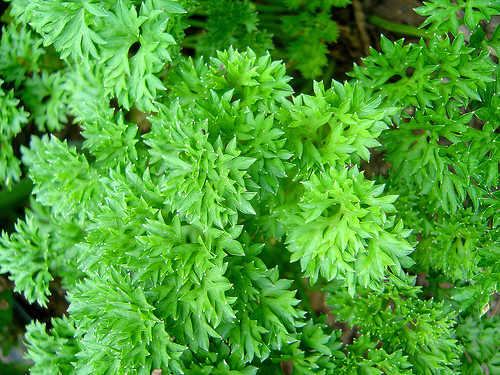
Image courtesy Flickr/RaeAllen
What is parsley?
Parsley is related to celery, and it has a flavor which is similar to that of celery leaves. This Mediterranean herb was revered by the ancient Greeks, who used it to adorn both winning athletes and tombs. Charlemagne popularized parsley in Europe in the Middle Ages: he was a big fan of the herb, and had it grown on his estate.
The two forms of parsley you will most often encounter at the store are curly and Italian or flat-leafed parsley. The Italian flat-leaf variety is slightly less bitter than the curly type, and is more tender. It also has more essential oils than the curly variety, which not only makes it more flavorful, it also means it has a bigger health impact.
Curly parsley is generally intended for use as a garnish, whereas the Italian flat-leaf style is most often used in cooking.
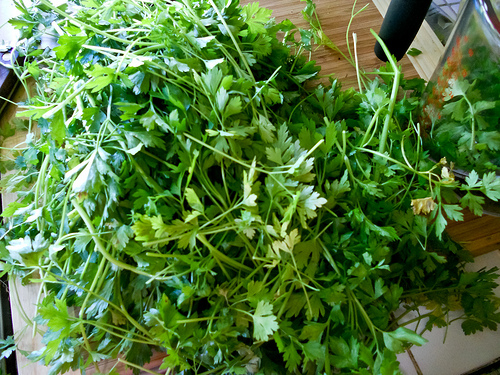
Image courtesy Flickr/kightp
Parsley's health benefits
Parsley is rich in a lot of antioxidant flavonoids and powerhouse volatile oils, the same substances which give parsley its rich flavor. Parsley contains the volatile oils myristicin, limonene, eugenol, and alpha-thujene, as well as the flavonoids aplin, apigenin, crisoerol, and luteolin.
Parsley is also high in vitamins C and K, beta-carotene, and folic acid. That's a lot of nutrition in one little leafy bit of garnish!
A note: parsley is one of the few foods that contain oxalates. These are not a problem for healthy people, but those with reduced gall bladder or kidney function will want to avoid parsley.
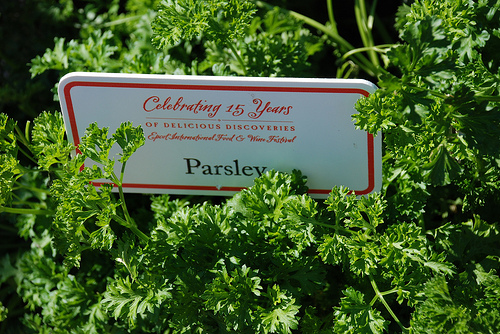
Image courtesy Flickr/Joe Shlabotnik
Choosing and storing parsley
Whenever possible, choose fresh parsley over dried. Dried parsley is convenient, but it also lacks a lot of the flavor and the nutritional benefits of fresh parsley. Choose bundles of parsley that are bright green, without any faded bits.
Fresh parsley never seems to last very long in the fridge before turning black and slimy, so it's probably good that it's usually so cheap. You can get your parsley to last longer by treating it like fresh flowers: cut off the ends, put it in a jar of water, cover it loosely with a plastic bag, and store it in the fridge. (The same technique also works for cilantro.) Don't wash it before you store it, or the extra water will make it go bad more quickly. Instead, swish it through a bowl of water right before you use it.
The easiest way to chop a bunch of parsley is to cut the leaf bundle at an angle. Here's a video on the technique. This is a real time-saver!
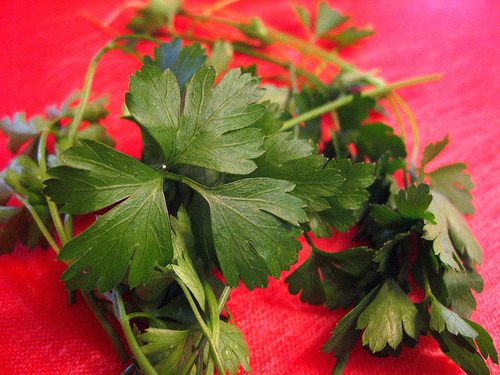
Image courtesy Flickr/Micaela Vega
Cooking with parsley
Parsley is one of those all-purpose ingredients that can be added to just about any recipe. It can be minced and added to soups, salads, and spaghetti sauce to add a great extra flavor. I most often use minced parsley in meatloaf, where it lends a bright flavor that helps bring out the savory taste.
When you are making soup, if you want to avoid giving your soup a greenish hue, you can use parsley stems instead of leaves. The stems have the same flavor as the leaves, but they won't break down and color your soup.

Image courtesy Flickr/revger
Parsley is one of the main ingredients in persillade, a French seasoning paste made from parsley minced with garlic, olive oil, and salt. Persillade is excellent as both flavoring and a last-minute garnish, and is common in Cajun cuisine as well as traditional French cooking. Persillade is good on anything that is tasty with garlic, including lamb, oysters, and chicken.
If you want to showcase parsley, tabouli (also spelled "tabbouleh") is a traditional Middle Eastern dish made with bulgur, chopped onions, tomatoes, and cucumbers, and a big mess of minced parsley and mint. Toss it together with lemon juice, olive oil, and salt, and enjoy. Make it with quinoa instead of bulgur for a gluten-free version. Here's a great basic recipe.
Image courtesy Flickr/Jane Starz
